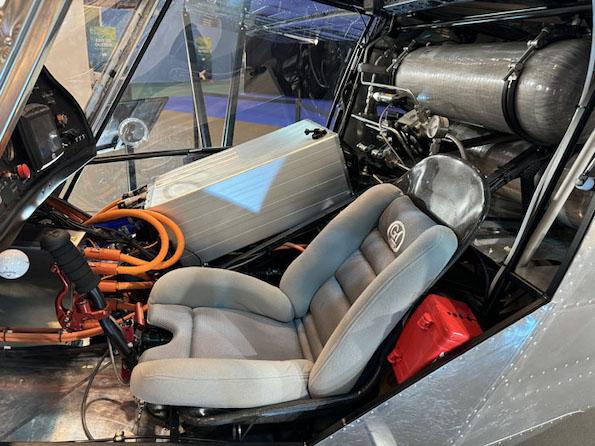
Beyond Aero’s demonstrator flew with a fuel cell installed next to the pilot’s seat and gaseous hydrogen tanks behind it.
GENEVA—After successful flight-testing of a demonstrator, Beyond Aero’s engineers are delving into the design of the One, an electric business jet relying on a hydrogen fuel cell, CEO and co-founder Eloa Guillotin said May 28. At the European Business Aviation Conference and Exhibition here, the Toulouse-based startup company is exhibiting the modified ultralight aircraft that flew with a small-scale powertrain in February.
Beyond Aero epitomizes the burgeoning startup sector in civil aeronautics, with ambitious decarbonization goals, challenging technology choices and arduous fundraising efforts. It is unique in that the project is taking place in business aviation. It might thus fit the bill for what the industry wants to be seen as good at: pioneering technologies that may significantly cut aviation’s carbon footprint.

The would-be airframer has raised €24 million ($25 million) so far. While the amount shows investors believe in the project, hundreds of millions of euros would be required to develop and produce a new aircraft like the One. Moreover, the schedule devised in 2021 for the One has already been lengthened by three years. Beyond Aero now says first delivery will occur “before 2030.”
Beyond Aero’s 40 employees are mostly engineers, and they are working on the One’s architecture, Guillotin said. To begin with, they are working on the powertrain, scaled up from the demonstrator’s, starting with a digital twin.
Hydrogen fuel tanks will be located on the underside of the fuselage, including the wing root area. Beyond Aero has elected to use 700-bar gaseous hydrogen, as opposed to the liquid hydrogen Airbus has preferred. The gas option is much more straightforward for development, Guillotin said.
The cooling system is the other main focus for the engineers, she added. A fuel cell is more efficient than a turbine engine, but for 1 megawatt of propulsive power, 1 megawatt of waste heat still has to dissipate. The absence of a natural gaseous flow as in conventional engines, make cooling more difficult. Therefore, a fuel cell’s cooling system requires a large air intake, which creates challenging drag. On the One, the intake will be situated around the fuselage.
As the four fuel cells will need to be fed with oxygen, and the aircraft flies at altitudes where the air is thinner, large compressors will be needed, Guillotin pointed out. Despite those features, Beyond Aero’s engineers are trying to keep the aircraft’s configuration as conventional as possible. They want to avoid unnecessary hurdles in the certification process. They are aiming to have the business jet—designed with between six and eight seats and a range of 800-1,000 nm—approved under the European Union Aviation Safety Agency’s (EASA) CS-23 regulation.
One more endeavor for Beyond Aero lies in certification rules for hydrogen-powered aircraft, which have yet to be created. “A large part is being co-written with the EASA and players such as Airbus,” Guillotin said.
The demonstrator was based on a G1 Aviation ultralight aircraft. Beyond Aero modified it, essentially with an electric motor, a fuel cell and three 340-bar hydrogen tanks for a total 1.2 kg (2.6 lb.) of hydrogen. Total power stood at 85 kW, including the unspecified power boost a battery provided at takeoff. Data analysis from the 10 takeoffs, including two for complete flights, is almost complete, Guillotin said. The aircraft flew at speeds up to 60 kt and altitudes up to 2,300 ft.
